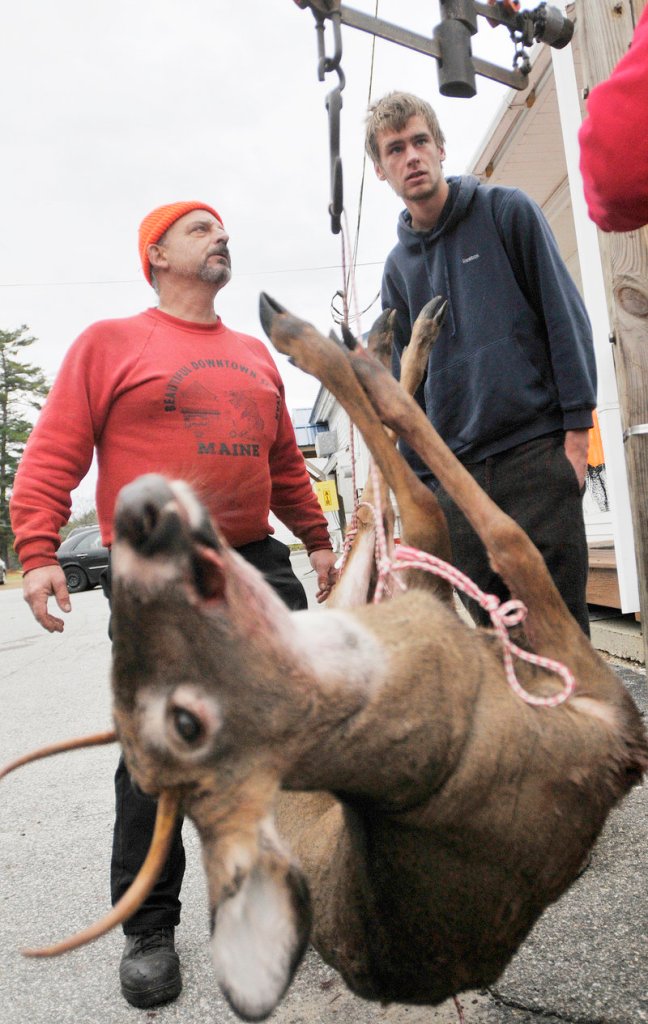White-tailed deer range from Canada to Bolivia, some 4,500 miles away.
But in northern Maine, once an ideal habitat for white-tails, their numbers are plummeting. And that’s bad news, both for wildlife groups and for hunters, whose season opened Saturday.
Severe winters and changing forests have done most of the damage, making survival for the white-tail herd so tough that its northern range is steadily moving south.
“That line used to be up a little higher, near the St. Lawrence River, when we didn’t have coyotes,” said New Brunswick deer biologist Rod Cumberland. “It has dropped down to northern Maine and eastern New Brunswick. That’s hard for people to accept.”
In northern Maine, the average snow depth and threat from coyotes and the loss of traditional wintering areas have made the region less hospitable for white-tailed deer, state deer biologist Lee Kantar said.
And over the past 30 years, those factors have caused a gradual shrinking of the white-tailed deer population in northern Maine, Kantar said.
“The northern forest changed dramatically from what it was in the ’70s. And coyotes are more prolific. Bears can influence fawn mortality. Every one of these things create a cumulative effect,” Kantar said.
In this region, a good six-hour drive from Portland, biologists and other supporters, including some from the forest industry, are taking a hard look at the future of the white-tailed herd.
But the reality is northern Maine’s climate and landscape are far different from the rest of the state’s.
And the biggest challenges facing white-tailed deer appear to be here to stay, said Kantar.
DIFFERENT CLIMATE
The average annual snowfall in Aroostook County has steadily increased over the past 30 years, including seven straight years of more than 110 inches in the 1990s.
Once snowfall gets over 2 feet, it becomes difficult for deer to move.
Warmer winters like last year’s, when just 70 inches of snow fell in Aroostook County, won’t necessarily help either, according to meteorologists.
“A warmer winter could mean a snowier winter because a warmer atmosphere could hold more moisture,” said forecaster Mark Bloomer with the National Weather Service in Caribou.
“It’s great having mild winters,” said Kantar. “But you still have predation. We still don’t have enough wintering habitat, or as much as we’d like. You still have problems, even when it’s going well.”
ON COYOTES
Across the St. John River in New Brunswick, white-tailed deer numbers are so low that four hunting districts there have been closed for 17 years.
Cumberland, the New Brunswick deer biologist, blames a growing coyote population.
Today, liberal coyote hunting laws exist in both New Brunswick and Maine, with year-round seasons and no bag limits, but it doesn’t seem to be having much of an effect.
Around sporting camps in Maine’s north woods, coyotes are viewed as a growing problem and common pest.
“You can see them from the air, actually spot them walking down the roads. You hear them close to the camp at night, even with the dogs. That was not as much growing up,” said Matt Libby, 30, owner of Libby Camps near Ashland.
Without ample wintering areas to protect deer from coyote packs, Kantar said the whitetails struggle to escape.
CHANGING FORESTLAND
Today, much more of Maine’s forestland is harvested for wood products, making life tough for deer, said biologist Barry Burgason, who advises the Maine Forest Products Council.
The older softwood and ancient stands of spruce fir that provided ample cover for deer have diminished, Burgason said.
Partial cutting practices have also been a problem.
The larger clear cuts of the 1970s that created a public outcry were actually better suited to deer because they resulted in lots of browse, or new forest growth, which deer like to eat, said Burgason.
Since then, large paper companies have become more sensitive to helping all wildlife, points out James Cote of the Maine Forest Products Council.
“Forestland is certified within 8 million acres that doesn’t allow for the destruction of wildlife habitat. It’s strictly monitored,” Cote said.
A state committee of interested groups was formed in 2007 to examine the northern herd after concerns rose over its diminishing numbers.
It’s expected to consider adopting recommendations this year.
But Cote wonders if the state should work so hard to benefit one species when many others are flourishing in the northern forest.
“Is it fair for the state to require management of white-tailed deer when there are few white-tailed deer in some areas? Or on the flip side, do you sustain high populations of moose and bear. I think it’s an important discussion to have,” Cote said.
Kantar agreed moose, bear and Canada lynx are thriving up north. And the state’s deer biologist said the diminishing deer herd is a complex problem.
“The timber industry isn’t doing anything bad. It employs a lot of people and that’s a good thing. But the forest economy has changed since the 1970s. There are more roads, more uses for wood and all kinds of markets for it. That’s a good thing.
“It’s just not a great thing for deer,” Kantar said.
Staff Writer Deirdre Fleming can be contacted at 791-6452 or at: dfleming@pressherald.com
Send questions/comments to the editors.




Success. Please wait for the page to reload. If the page does not reload within 5 seconds, please refresh the page.
Enter your email and password to access comments.
Hi, to comment on stories you must . This profile is in addition to your subscription and website login.
Already have a commenting profile? .
Invalid username/password.
Please check your email to confirm and complete your registration.
Only subscribers are eligible to post comments. Please subscribe or login first for digital access. Here’s why.
Use the form below to reset your password. When you've submitted your account email, we will send an email with a reset code.